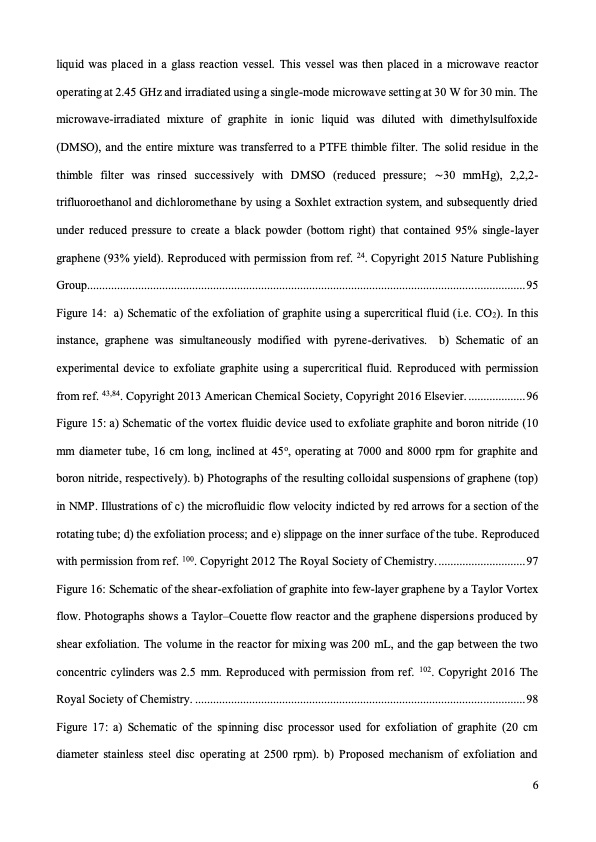
PDF Publication Title:
Text from PDF Page: 006
liquid was placed in a glass reaction vessel. This vessel was then placed in a microwave reactor operating at 2.45 GHz and irradiated using a single-mode microwave setting at 30 W for 30 min. The microwave-irradiated mixture of graphite in ionic liquid was diluted with dimethylsulfoxide (DMSO), and the entire mixture was transferred to a PTFE thimble filter. The solid residue in the thimble filter was rinsed successively with DMSO (reduced pressure; ∼30 mmHg), 2,2,2- trifluoroethanol and dichloromethane by using a Soxhlet extraction system, and subsequently dried under reduced pressure to create a black powder (bottom right) that contained 95% single-layer graphene (93% yield). Reproduced with permission from ref. 24. Copyright 2015 Nature Publishing Group.................................................................................................................................................. 95 Figure 14: a) Schematic of the exfoliation of graphite using a supercritical fluid (i.e. CO2). In this instance, graphene was simultaneously modified with pyrene-derivatives. b) Schematic of an experimental device to exfoliate graphite using a supercritical fluid. Reproduced with permission from ref. 43,84. Copyright 2013 American Chemical Society, Copyright 2016 Elsevier....................96 Figure 15: a) Schematic of the vortex fluidic device used to exfoliate graphite and boron nitride (10 mm diameter tube, 16 cm long, inclined at 45o, operating at 7000 and 8000 rpm for graphite and boron nitride, respectively). b) Photographs of the resulting colloidal suspensions of graphene (top) in NMP. Illustrations of c) the microfluidic flow velocity indicted by red arrows for a section of the rotating tube; d) the exfoliation process; and e) slippage on the inner surface of the tube. Reproduced with permission from ref. 100. Copyright 2012 The Royal Society of Chemistry..............................97 Figure 16: Schematic of the shear-exfoliation of graphite into few-layer graphene by a Taylor Vortex flow. Photographs shows a Taylor–Couette flow reactor and the graphene dispersions produced by shear exfoliation. The volume in the reactor for mixing was 200 mL, and the gap between the two concentric cylinders was 2.5 mm. Reproduced with permission from ref. 102. Copyright 2016 The Royal Society of Chemistry. .............................................................................................................. 98 Figure 17: a) Schematic of the spinning disc processor used for exfoliation of graphite (20 cm diameter stainless steel disc operating at 2500 rpm). b) Proposed mechanism of exfoliation and 6PDF Image | graphene production via nonoxidizing liquid exfoliation

PDF Search Title:
graphene production via nonoxidizing liquid exfoliationOriginal File Name Searched:
Graphene-R2-review.pdfDIY PDF Search: Google It | Yahoo | Bing
Salgenx Redox Flow Battery Technology: Power up your energy storage game with Salgenx Salt Water Battery. With its advanced technology, the flow battery provides reliable, scalable, and sustainable energy storage for utility-scale projects. Upgrade to a Salgenx flow battery today and take control of your energy future.
| CONTACT TEL: 608-238-6001 Email: greg@infinityturbine.com | RSS | AMP |